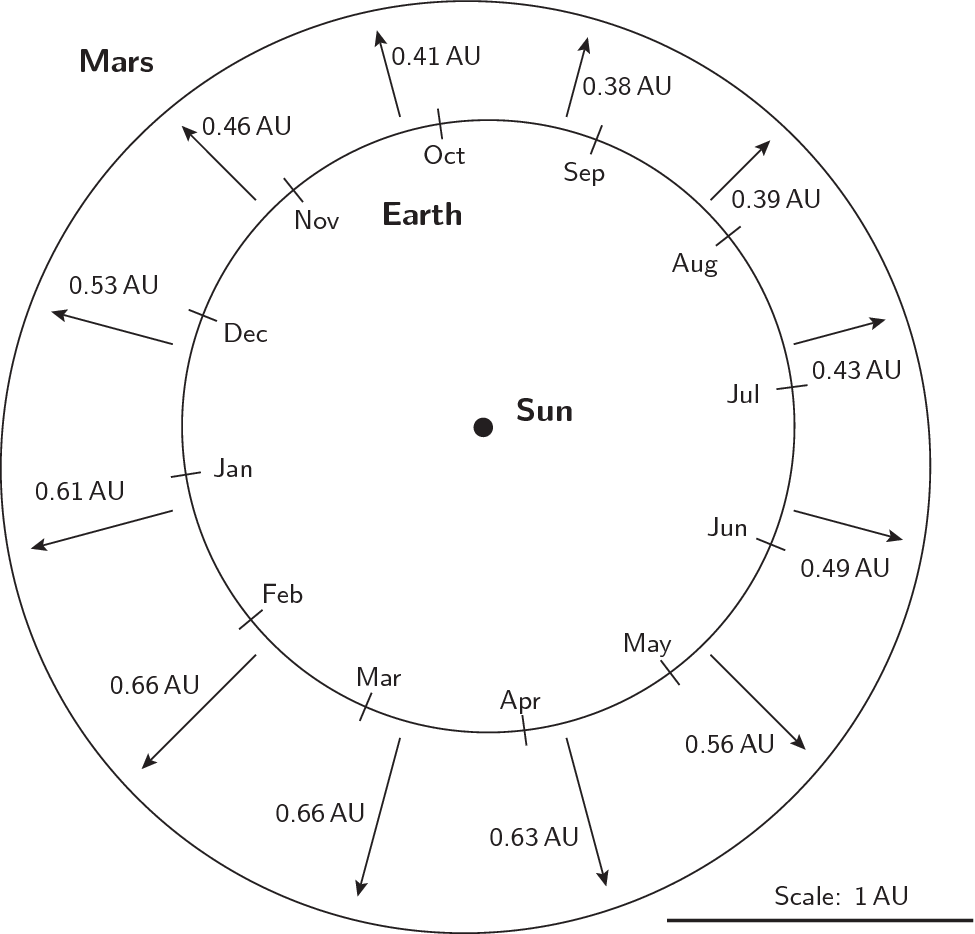The next few months will bring the best opportunity to observe Mars for many years to come.
Already a prominent sight in the pre-dawn sky, Mars will gradually brighten in coming weeks. Since mid-August it has been brighter than Sirius, the brightest star in the night sky. By mid-September, it will surpass Jupiter to become the second-brightest planet after Venus – which is also a brilliant sight in the morning sky currently.
It will continue to brighten until it makes closest approach to the Earth (perigee) on 6 October, at a distance of 0.415 AU from us. Seen through a telescope, it will grow in size as it nears the Earth, reaching a maximum size of 22.6 arcseconds across at perigee. At the same time, it will reach a maximum brightness of magnitude -2.6.
Mars appears in the night sky once every 2.1 years, when it is said to be at opposition. The term opposition refers to an optimal alignment in which Mars, the Earth and the Sun lie in a straight line in space, with the Earth in the middle. This alignment means that Mars appears almost directly opposite the Sun in the sky. It occurs whenever the Earth overtakes Mars in its neighbouring orbit, like two runners in a celestial racetrack. Mars moves around the Sun more slowly than the Earth, circling it once every 1.9 years while the Earth does so once a year, and so the Earth "laps" Mars every 2.1 years.
As the two planets pass each other, Mars makes its closest approach to the Earth and appears larger and brighter than at other times. Lying opposite to the Sun in the sky, it also appears high in the sky for much of the night.
However, not all oppositions of Mars are equally spectacular. This year's event will be well worth observing since Mars will appear larger (when seen through a telescope) and brighter than at most oppositions.
This comes about because Mars is unusual in having an oval-shaped elliptical orbit, whereas most of the planets follow orbits which are almost exactly circular. The shapes of the orbits of Mars and the Earth are drawn to scale below:

The oval shape of Mars's orbit is especially evident when it is drawn next to the Earth's highly circular orbit. While the Earth's distance from the Sun changes by only 3% over the course of the year, Mars's distance from the Sun varies by nearly 20%. Historically, it was observations of Mars's motion across the sky that convinced Johannes Kepler that planetary orbits had to be elliptical rather than circular, since he could not fit any circular orbit to Tycho Brahe's observations of Mars's path. It is curious to think that if Mars had had a circular orbit, Kepler would have had no reason to think that all planets did not follow circular orbits.
The elliptical shape of Mars's orbit means that when the Earth and Mars pass each other in their respective orbits, they do not always do so at the same distance. If an opposition of Mars occurs when the red planet is at its furthest from the Sun (a aphelion opposition), it may come no closer than 0.66 AU from the Earth. This is what happens when Mars comes to opposition around March.
The best views of Mars are to be had when it comes to opposition around August–October, when the Earth lies next to the part of Mars's orbit where it comes closest to the Sun. When an opposition occurs at this time of year, Mars can come within 0.41 AU of the Earth, appearing 60% larger than at a March opposition, and a whole magnitude brighter.
An additional consideration for observers in the northern hemisphere is that during the summer months, when the Sun is high in the northern sky, any object lying opposite to the Sun in the sky will lie deep in the southern sky. Thus, when Mars comes to opposition in the summer months, it will not rise very far above the horizon as seen from northern latitudes.
Since atmospheric turbulence is worst close to the horizon, observers at high northern latitudes get their best views of Mars when it climbs at least 30-40° above the horizon. This only happens when Mars comes to opposition towards the end of the August–October window.
In 2020, Mars comes to opposition on 14 October. While it will not appear quite so large as it did at other recent perihelion oppositions – in 2018 and 2003 – its higher altitude in the sky will more than make up for this for northern observers.
The sky on 23 Aug 2020
| The sky on 23 August 2020 | ||||||||||||||||||||||||||||||||||
|
28% 4 days old |
All times shown in PDT.
|
|||||||||||||||||||||||||||||||||
Source
The circumstances of this event were computed using the DE430 planetary ephemeris published by the Jet Propulsion Laboratory (JPL).
This event was automatically generated by searching the ephemeris for planetary alignments which are of interest to amateur astronomers, and the text above was generated based on an estimate of your location.
Image credit
© NASA/Hubble Space Telescope
